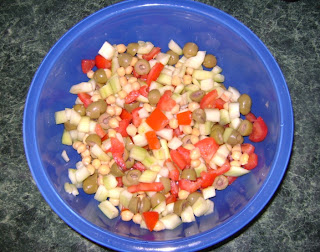I've got an end-of-year work potluck tomorrow, so I made one of my favorite potluck dishes. I adapted the recipe from the recipe for "Shirazi Cucumber & Pomegranate Salad" in
Silk Road Cooking: A Vegetarian Journey by Najmieh Batmanglij. This is an AMAZING cookbook - full of Persian recipes plus recipes from everywhere in Asia from the Mediterranean to the Pacific. So many cookbooks just focus on the Middle East or India/Pakistan, but this one has some really unique recipes from Iran and nearby countries in Central Asia too.
The original recipe is a salad of cucumbers, onions, olives, and pomegranate seeds, with a dressing that has a pomegranate base. The key taste here is the contrast between the olives and pomegranates, but I didn't want to put off anyone who was unfamiliar with the texture of pomegranate seeds or was turned off by pieces of raw onion. So, I left out the onions and pomegranate seeds, and added chopped tomatoes, making it look a little bit more like the more familiar Jerusalem Salad that's typical to Middle Eastern cooking. And I added chickpeas to upgrade it to entree salad level.
Persian Salad with Olives and Pomegranate
Salad:
2 cucumbers
3 medium tomatoes
1-1/2 cups pitted green olives
1-1/2 cups cooked or canned chick peas
Dressing:
2 cloves garlic, peeled
1 tbsp. pomegranate concentrate
1 tbsp. lime juice
1 tbsp. honey
1 tsp. salt
1/2 tsp. black pepper
1/4 tsp. red pepper flakes
1/2 cup olive oil
1) Peel the cucumbers, then scoop the seeds out of the cucumbers & tomatoes. Scooping the seeds out is easy - just cut the cucumber lengthwise and scrape them out with a spoon. Cut the tomato across the center and do the same thing.
Or you could just buy seedless cucumbers and save a step.
2) Mix together the cucumbers, tomatoes, olives, and chick peas. I don't like the taste of canned olives, so I bought the Taamti brand, which is refrigerated. I've also used Kvuzat Yavne brand, which comes in jars - both are Israeli brands and kosher, and best of all, they're already pitted. I cut the olives in half.
3) Now for the dressing - the key ingredient in this dressing is Pomegranate Concentrate, which is just what it sounds like - a concentrated pomegranate juice. It's sold in Middle Eastern groceries, or you could make your own by simmering pomegranate juice to make a thick reduction. The brand I used is Sadaf, which has a nice sweet taste, and is also kosher. Other brands that sell this are Ziyad and Sultan.
The original recipe called for sesame oil, but I left that out this time - it does add a more complex taste combo, but I wanted the tang of the dressing to really shine. I also increased the amount of honey and garlic, two ingredients you can't have too much of.
I love juicing limes (and lemons) - gives me an excuse to use this little gadget whose name I can't remember. Gets the smell of the garlic cloves off my hands too.
4) Blend all the ingredients together - a blender gives the best consistency, but you can use a whisk (just crush or mince the garlic first). I used my Magic Bullet, which is my favorite electronic gadget that I initially made fun of my husband for buying after he saw the infomercial.
5) Mix the dressing through with the salad. It's a good idea to make it a day ahead so the flavors can meld while it's sitting in the fridge.
6) You can eat the salad on it's own, or on a bed of greens - arugula's peppery taste compliments it nicely.























